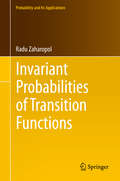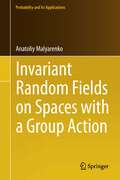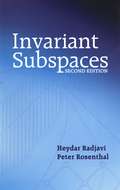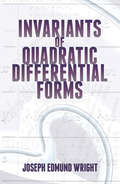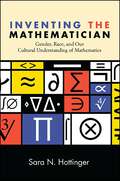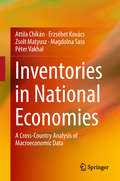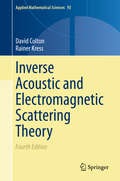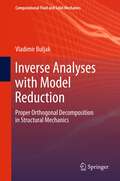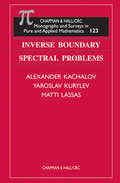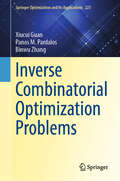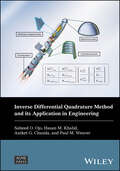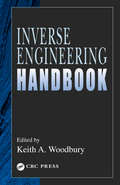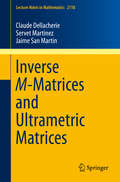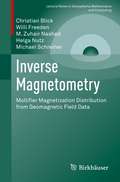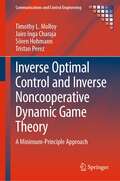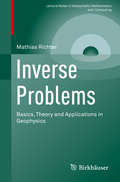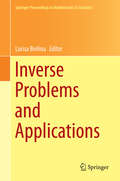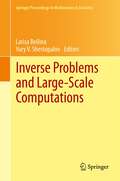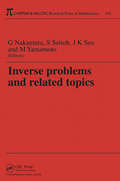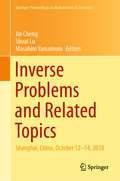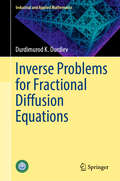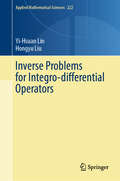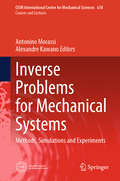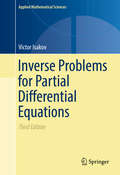- Table View
- List View
Invariant Probabilities of Transition Functions
by Radu ZaharopolThe structure of the set of all the invariant probabilities and the structure of various types of individual invariant probabilities of a transition function are two topics of significant interest in the theory of transition functions, and are studied in this book. The results obtained are useful in ergodic theory and the theory of dynamical systems, which, in turn, can be applied in various other areas (like number theory). They are illustrated using transition functions defined by flows, semiflows, and one-parameter convolution semigroups of probability measures. In this book, all results on transition probabilities that have been published by the author between 2004 and 2008 are extended to transition functions. The proofs of the results obtained are new. For transition functions that satisfy very general conditions the book describes an ergodic decomposition that provides relevant information on the structure of the corresponding set of invariant probabilities. Ergodic decomposition means a splitting of the state space, where the invariant ergodic probability measures play a significant role. Other topics covered include: characterizations of the supports of various types of invariant probability measures and the use of these to obtain criteria for unique ergodicity, and the proofs of two mean ergodic theorems for a certain type of transition functions. The book will be of interest to mathematicians working in ergodic theory, dynamical systems, or the theory of Markov processes. Biologists, physicists and economists interested in interacting particle systems and rigorous mathematics will also find this book a valuable resource. Parts of it are suitable for advanced graduate courses. Prerequisites are basic notions and results on functional analysis, general topology, measure theory, the Bochner integral and some of its applications.
Invariant Random Fields on Spaces with a Group Action
by Nicolai Leonenko Anatoliy MalyarenkoThe author describes the current state of the art in the theory of invariant random fields. This theory is based on several different areas of mathematics, including probability theory, differential geometry, harmonic analysis, and special functions. The present volume unifies many results scattered throughout the mathematical, physical, and engineering literature, as well as it introduces new results from this area first proved by the author. The book also presents many practical applications, in particular in such highly interesting areas as approximation theory, cosmology and earthquake engineering. It is intended for researchers and specialists working in the fields of stochastic processes, statistics, functional analysis, astronomy, and engineering.
Invariant Subspaces
by John A. Nohel Heydar RadjaviBroad survey focuses on operators on separable Hilbert spaces. Topics include normal operators, analytic functions of operators, shift operators, invariant subspace lattices, compact operators, invariant and hyperinvariant subspaces, von Neumann algebras, transitive operator algebras, and algebras associated with invariant subspaces. 1973 edition. New Appendix on Recent Developments.
Invariants of Quadratic Differential Forms (Dover Books on Mathematics)
by Joseph Edmund WrightThis classic monograph by a mathematician affiliated with Trinity College, Cambridge, offers a brief account of the invariant theory connected with a single quadratic differential form. Suitable for advanced undergraduates and graduate students of mathematics, it avoids unnecessary analysis and offers an accessible view of the field for readers unfamiliar with the subject.A historical overview is followed by considerations of the methods of Christoffel and Lie as well as Maschke's symbolic method and explorations of geometrical and dynamical methods. The final chapter on applications, which draws upon developments by Ricci and Levi-Civita, presents the most successful method and can be read independently of the rest of the book.
Inventing the Mathematician: Gender, Race, and Our Cultural Understanding of Mathematics
by Sara N. HottingerWhere and how do we, as a culture, get our ideas about mathematics and about who can engage with mathematical knowledge? Sara N. Hottinger uses a cultural studies approach to address how our ideas about mathematics shape our individual and cultural relationship to the field. She considers four locations in which representations of mathematics contribute to our cultural understanding of mathematics: mathematics textbooks, the history of mathematics, portraits of mathematicians, and the field of ethnomathematics. Hottinger examines how these discourses shape mathematical subjectivity by limiting the way some groups—including women and people of color—are able to see themselves as practitioners of math. Inventing the Mathematician provides a blueprint for how to engage in a deconstructive project, revealing the limited and problematic nature of the normative construction of mathematical subjectivity.
Inventories in National Economies: A Cross-country Analysis Of Macroeconomic Data
by Attila Chikán Erzsébet Kovács Zsolt Matyusz Magdolna Sass Péter VakhalThis book introduces a new approach in the field of macroeconomic inventory studies: the use of multivariate statistics to evaluate long-term characteristics of inventory investments in developed countries. By analyzing a 44-year period series of annual inventory change in percentage of GDP in a set of OECD countries, disclosing their relationship to growth, industry structure and alternative uses of GDP (fixed capital investments, foreign trade and consumption), it fills a gap in the economic literature. It is generally accepted that inventories play an important role in all levels of the economy. However, while there is extensive literature on micro- (and even item-) level inventory problems, macroeconomic inventory studies are scarce. Both the long-term processes of inventory formation and their correlation with other macroeconomic factors provide interesting conclusions about economic changes and policies in our immediate past, and present important insights for the future.
Inverse Acoustic and Electromagnetic Scattering Theory
by Rainer Kress David ColtonThe inverse scattering problem is central to many areas of science and technology such as radar and sonar, medical imaging, geophysical exploration and nondestructive testing. This book is devoted to the mathematical and numerical analysis of the inverse scattering problem for acoustic and electromagnetic waves. In this third edition, new sections have been added on the linear sampling and factorization methods for solving the inverse scattering problem as well as expanded treatments of iteration methods and uniqueness theorems for the inverse obstacle problem. These additions have in turn required an expanded presentation of both transmission eigenvalues and boundary integral equations in Sobolev spaces. As in the previous editions, emphasis has been given to simplicity over generality thus providing the reader with an accessible introduction to the field of inverse scattering theory. Review of earlier editions: "Colton and Kress have written a scholarly, state of the art account of their view of direct and inverse scattering. The book is a pleasure to read as a graduate text or to dip into at leisure. It suggests a number of open problems and will be a source of inspiration for many years to come." SIAM Review, September 1994 "This book should be on the desk of any researcher, any student, any teacher interested in scattering theory." Mathematical Intelligencer, June 1994
Inverse Acoustic and Electromagnetic Scattering Theory (Applied Mathematical Sciences #93)
by Rainer Kress David ColtonThe inverse scattering problem is central to many areas of science and technology such as radar, sonar, medical imaging, geophysical exploration and nondestructive testing. This book is devoted to the mathematical and numerical analysis of the inverse scattering problem for acoustic and electromagnetic waves. In this fourth edition, a number of significant additions have been made including a new chapter on transmission eigenvalues and a new section on the impedance boundary condition where particular attention has been made to the generalized impedance boundary condition and to nonlocal impedance boundary conditions. Brief discussions on the generalized linear sampling method, the method of recursive linearization, anisotropic media and the use of target signatures in inverse scattering theory have also been added.
Inverse Analyses with Model Reduction
by Vladimir BuljakIn this self-consistent monograph, the author gathers and describes different mathematical techniques and combines all together to form practical procedures for the inverse analyses. It puts together topics coming from mathematical programming, with soft computing and Proper Orthogonal Decomposition, in order to show, in the context of structural analyses, how the things work and what are the main problems one needs to tackle. Throughout the book a number of examples and exercises are worked out in order to make reader practically familiar with discussed topics.
Inverse Boundary Spectral Problems (Monographs and Surveys in Pure and Applied Mathematics)
by Alexander Kachalov Yaroslav Kurylev Matti LassasInverse boundary problems are a rapidly developing area of applied mathematics with applications throughout physics and the engineering sciences. However, the mathematical theory of inverse problems remains incomplete and needs further development to aid in the solution of many important practical problems.Inverse Boundary Spectral Problems
Inverse Combinatorial Optimization Problems (Springer Optimization and Its Applications #225)
by Panos M. Pardalos Xiucui Guan Binwu ZhangThis book offers as exploration into the emerging field of Inverse Combinatorial Optimization Problems (ICOPs), a transformative area within operations research. As traditional optimization focuses on maximizing or minimizing objectives under constraints, ICOPs reverse this process, allowing for the inference of hidden parameters from observed outcomes. This monograph provides a comprehensive framework for understanding and applying ICOPs across various domains. Key concepts such as inverse shortest path, spanning tree, and center location problems are meticulously examined, offering theoretical insights and algorithmic solutions. The authors present a structured approach to these complex problems, making this work an essential resource for both academic and practical applications. By addressing critical questions and providing algorithmic tools, this book is a must-read for those seeking to enhance network design, logistics, and strategic planning. Researchers, academics, and practitioners in operations research and management science will find this monograph invaluable. It not only contributes to academic discourse but also equips professionals with the knowledge to tackle real-world challenges. This book is a vital addition to any library supporting advanced studies in optimization and decision-making processes.
Inverse Differential Quadrature Method and its Application in Engineering (Wiley-ASME Press Series)
by Saheed O. Ojo Hasan M. Khalid Aniket G. Chanda Paul M. WeaverInverse Differential Quadrature Method and its Application in Engineering Authoritative reference introducing iDQM as a numerical tool to accurately perform high fidelity analyses efficiently for solving problems in engineering governed by higher-order ordinary and partial differential equations. Inverse Differential Quadrature Method and its Application in Engineering is the first book to comprehensively cover the development of a new numerical solution technique: the inverse differential quadrature method (iDQM), as an indirect approximation technique that can circumvent numerical differentiation-induced errors in the solution of systems of higher-order differential equations. The book’s introduction highlights the historical development of numerical methods in the field while emphasising the significance of strong-form solution methods. Detailed derivations of iDQM formulations in one- and two-dimensions, approximation procedures, and error quantification are described. The subsequent chapters describe the application of iDQM to many fields of engineering including structures, heat flow, fluids, waves and multiphysics problems. Example applications covering linear and nonlinear systems are demonstrated with simple and detailed discretisation steps to aid reader understanding of iDQM. MATLAB codes for many of the illustrative examples in the book are provided to ease implementation and practice for readers. Written by a team of highly qualified academics, Inverse Differential Quadrature Method and its Application in Engineering discusses topics including: High fidelity linear and non-linear structural analyses of variable-stiffness curved beams, arbitrary-shaped plates, and cylindrical and spherical shells governed by unified formulation kinematicsiDQM error formulation and its effect on spectral convergenceAccurate and efficient solutions of non-structural problems governed by, for example, Korteweg-de Vries (KdV) wave, Helmholtz, convection-diffusion and steady state heat conduction equations and nonlinear one- and two-dimensional scalar combustion modelsStrategies to alleviate mathematical ill-conditioning of system matrices employing novel preconditioning techniques Inverse Differential Quadrature Method and its Application in Engineering is an essential reference for researchers and engineers performing advanced numerical analysis across a range of applications in the mechanical, aerospace, chemical, and civil engineering industries, along with graduate students in related programs of study.
Inverse Engineering Handbook (Handbook Series for Mechanical Engineering)
by Keith A. WoodburyInverse problems have been the focus of a growing number of research efforts over the last 40 years-and rightly so. The ability to determine a "cause" from an observed "effect" is a powerful one. Researchers now have at their disposal a variety of techniques for solving inverse problems, techniques that go well beyond those useful for relatively si
Inverse M-Matrices and Ultrametric Matrices
by Claude Dellacherie Servet Martinez Jaime San MartinThe study of M-matrices, their inverses and discrete potential theory is now a well-established part of linear algebra and the theory of Markov chains. The main focus of this monograph is the so-called inverse M-matrix problem, which asks for a characterization of nonnegative matrices whose inverses are M-matrices. We present an answer in terms of discrete potential theory based on the Choquet-Deny Theorem. A distinguished subclass of inverse M-matrices is ultrametric matrices, which are important in applications such as taxonomy. Ultrametricity is revealed to be a relevant concept in linear algebra and discrete potential theory because of its relation with trees in graph theory and mean expected value matrices in probability theory. Remarkable properties of Hadamard functions and products for the class of inverse M-matrices are developed and probabilistic insights are provided throughout the monograph.
Inverse Magnetometry: Mollifier Magnetization Distribution from Geomagnetic Field Data (Lecture Notes in Geosystems Mathematics and Computing)
by Willi Freeden M. Zuhair Nashed Michael Schreiner Christian Blick Helga NutzThis monograph presents the geoscientific context arising in decorrelative geomagnetic exploration. First, an insight into the current state of research is given by reducing magnetometry to mathematically accessible, and thus calculable, decorrelated models. In this way, various questions and problems of magnetometry are made available to a broad scientific audience and the exploration industry. New stimuli are given, and innovative ways of modeling geologic strata by mollifier magnetometric techniques are shown.Potential data sets primarily of terrestrial origin constitute the main data basis in the book. For deep geology, the geomathematical decorrelation methods are designed in such a way that depth information (e.g., in boreholes) may be canonically entered. Overall, this book provides pioneering and ground-breaking innovative mathematical knowledge as a transfer methodology from the “reality space” of magnetometric measurements into the “virtual space” of mathematical-numerical modeling structures and mollifier solutions with novel geological application areas. It pursues a double goal: On the one hand, it represents a geoscientific set of rules for today's geoengineering, interested in the application of innovative modelling and simulation techniques to promising data sets and structures occurring in geomagnetics. On the other hand, the book serves as a collection of current material in Applied Mathematics to offer alternative methodologies in the theory of inverse problems.
Inverse Optimal Control and Inverse Noncooperative Dynamic Game Theory: A Minimum-Principle Approach (Communications and Control Engineering)
by Timothy L. Molloy Sören Hohmann Tristan Perez Jairo Inga CharajaThis book presents a novel unified treatment of inverse problems in optimal control and noncooperative dynamic game theory. It provides readers with fundamental tools for the development of practical algorithms to solve inverse problems in control, robotics, biology, and economics. The treatment involves the application of Pontryagin's minimum principle to a variety of inverse problems and proposes algorithms founded on the elegance of dynamic optimization theory. There is a balanced emphasis between fundamental theoretical questions and practical matters. The text begins by providing an introduction and background to its topics. It then discusses discrete-time and continuous-time inverse optimal control. The focus moves on to differential and dynamic games and the book is completed by consideration of relevant applications. The algorithms and theoretical results developed in Inverse Optimal Control and Inverse Noncooperative Dynamic Game Theory provide new insights into information requirements for solving inverse problems, including the structure, quantity, and types of state and control data. These insights have significant practical consequences in the design of technologies seeking to exploit inverse techniques such as collaborative robots, driver-assistance technologies, and autonomous systems. The book will therefore be of interest to researchers, engineers, and postgraduate students in several disciplines within the area of control and robotics.
Inverse Problems
by Mathias RichterThe overall goal of the book is to provide access to the regularized solution of inverse problems relevant in geophysics without requiring more mathematical knowledge than is taught in undergraduate math courses for scientists and engineers. From abstract analysis only the concept of functions as vectors is needed. Function spaces are introduced informally in the course of the text, when needed. Additionally, a more detailed, but still condensed introduction is given in Appendix B. A second goal is to elaborate the single steps to be taken when solving an inverse problem: discretization, regularization and practical solution of the regularized optimization problem. These steps are shown in detail for model problems from the fields of inverse gravimetry and seismic tomography. The intended audience is mathematicians, physicists and engineers having a good working knowledge of linear algebra and analysis at the upper undergraduate level.
Inverse Problems and Applications
by Larisa BeilinaThis volume arose from the Third Annual Workshop on Inverse Problems, held in Stockholm on May 2-6, 2012. The proceedings present new analytical developments and numerical methods for solutions of inverse and ill-posed problems, which consistently pose complex challenges to the development of effective numerical methods. The book highlights recent research focusing on reliable numerical techniques for the solution of inverse problems, with relevance to a range of fields including acoustics, electromagnetics, optics, medical imaging, and geophysics.
Inverse Problems and Large-Scale Computations
by Larisa Beilina Yury V. ShestopalovThis volume is a result of two international workshops, namely the Second Annual Workshop on Inverse Problems and the Workshop on Large-Scale Modeling, held jointly in Sunne, Sweden from May 1-6 2012. The subject of the inverse problems workshop was to present new analytical developments and new numerical methods for solutions of inverse problems. The objective of the large-scale modeling workshop was to identify large-scale problems arising in various fields of science and technology and covering all possible applications, with a particular focus on urgent problems in theoretical and applied electromagnetics. The workshops brought together scholars, professionals, mathematicians, and programmers and specialists working in large-scale modeling problems. The contributions in this volume are reflective of these themes and will be beneficial to researchers in this area.
Inverse Problems and Related Topics (Chapman & Hall/CRC Research Notes in Mathematics Series)
by G Nakamura S Saitoh J K Seo M YamamotoInverse problems arise in many disciplines and hold great importance to practical applications. However, sound new methods are needed to solve these problems. Over the past few years, Japanese and Korean mathematicians have obtained a number of very interesting and unique results in inverse problems.Inverse Problems and Related Topics compi
Inverse Problems and Related Topics: Shanghai, China, October 12–14, 2018 (Springer Proceedings in Mathematics & Statistics #310)
by Jin Cheng Masahiro Yamamoto Shuai LuThis volume contains 13 chapters, which are extended versions of the presentations at International Conference on Inverse Problems at Fudan University, Shanghai, China, October 12-14, 2018, in honor of Masahiro Yamamoto on the occasion of his 60th anniversary. The chapters are authored by world-renowned researchers and rising young talents, and are updated accounts of various aspects of the researches on inverse problems. The volume covers theories of inverse problems for partial differential equations, regularization methods, and related topics from control theory. This book addresses a wide audience of researchers and young post-docs and graduate students who are interested in mathematical sciences as well as mathematics.
Inverse Problems for Fractional Diffusion Equations (Industrial and Applied Mathematics)
by Durdimurod K. DurdievThis book discusses various inverse problems for the time-fractional diffusion equation, such as inverse coefficient problems (nonlinear problems) and inverse problems for determining the right-hand sides of equations and initial functions (linear problems). The study of inverse problems requires a comprehensive investigation of direct problems (such as representation formulas, a priori estimates and differential properties of the solution). This is particularly evident in nonlinear problems, where obtaining solvability theorems necessitates careful tracking of the exact dependence of the differential properties of the solution to the direct problem on the smoothness of the coefficients and other problem data. Therefore, a significant portion of the book is devoted to direct problems, such as initial problems (Cauchy problems) and initial-boundary value problems with various boundary conditions.
Inverse Problems for Integro-differential Operators (Applied Mathematical Sciences #222)
by Hongyu Liu Yi-Hsuan LinInverse problems lie at the core of scientific discovery, enabling us to determine causes from observed consequences. They are fundamental to both theoretical research and technological innovation, making them a central topic in the mathematical sciences. This book explores a cutting-edge area of inverse problems—those related to integro-differential operators, also known as nonlocal operators. Due to their unique theoretical properties and vast practical applications, nonlocal inverse problems have garnered significant interest in recent years, making this an ideal time for a dedicated research monograph. Focusing on nonlocality in space, this book provides a systematic study of both forward and inverse problems associated with integro-differential operators. It introduces key properties of forward problems—well-posedness, maximum principles, and unique continuation—before delving into inverse problems, including modeling, unique identifiability, stability analysis, and reconstruction methods. The discussion bridges mathematical theory with real-world applications, offering insights into pioneering contributions as well as recent advances by the authors and their collaborators. As an evolving field, nonlocal inverse problems present a wealth of open challenges and emerging applications. This book not only provides a comprehensive introduction but also aims to inspire future research with fresh perspectives and novel insights. It is an invaluable resource for graduate students and early-career researchers looking to enter the field, as well as a valuable reference for experienced mathematicians working in inverse problems and mathematical analysis.
Inverse Problems for Mechanical Systems: Methods, Simulations and Experiments (CISM International Centre for Mechanical Sciences #618)
by Antonino Morassi Alexandre KawanoThis book explores the crucial role of inverse problems across various fields of applied science and technology. By examining physical phenomena governed by mathematical physics, it addresses the challenge of determining unknown parameters and developing non-destructive methods for systems of solid and structural mechanics. It delves into the inherent mathematical complexities of inverse problems and presents innovative strategies for overcoming these issues. Aimed at doctoral students and researchers in civil and mechanical engineering, mathematical physics, and applied mathematics, the book provides a solid theoretical foundation and equips readers with the necessary mathematical and computational tools to tackle diverse inverse problems.
Inverse Problems for Partial Differential Equations
by Victor IsakovA comprehensive description of the current theoretical and numerical aspects of inverse problems in partial differential equations. Applications include recovery of inclusions from anomalies of their gravity fields, reconstruction of the interior of the human body from exterior electrical, ultrasonic, and magnetic measurement. By presenting the data in a readable and informative manner, the book introduces both scientific and engineering researchers as well as graduate students to the significant work done in this area in recent years, relating it to broader themes in mathematical analysis.
